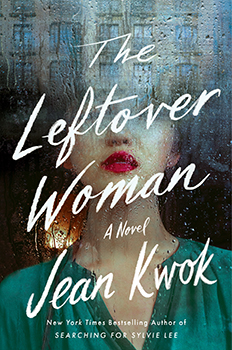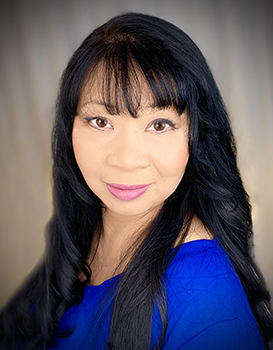A Love Letter to Motherhood and Belonging
The Big Thrill Interviews Jean Kwok
By K.L. Romo
 “Why is it that women have to pay the price for men’s desires?”
“Why is it that women have to pay the price for men’s desires?”
This is the question asked by the protagonist in Jean Kwok’s newest suspenseful literary masterpiece, THE LEFTOVER WOMAN. It is a story about two very different women and what each will do to protect the daughter they both love.
What is it like to feel invisible? Jasmine knows all too well.
“In China, I’d seen posters warning girls of the danger of becoming leftover women, women that no one wanted. Leftover like scraps on a table, uneaten food, both a sacrilege and wasteful, something that should have nourished our country squandered and turned into rubbish; unwanted, purposeless, of no use to anyone. I was a leftover woman, I realized.”
Jasmine’s marriage to her domineering husband, Wen, in China at age 14 was like going from one family prison to another. But she accepted her fate…until she snooped in Wen’s computer to confirm his infidelity and found a mysterious email: a man in America thanked her husband for the beautiful baby girl they’d given up for adoption.
Jasmine knew this was her baby who everyone told her died after birth. The realization hit her like a punch—Wen gave their baby daughter away because of China’s “one baby” law. He didn’t want a daughter. Jasmine flees to America to find her.
Sophisticated Rebecca is the Editor-in-Chief of a New York City publishing house and married to a successful and handsome husband. She has everything she could want—except an intimate relationship with their young adopted daughter, Fifi. Their Chinese nanny, Lucy, is Fifi’s favorite person. They’d hired Lucy—who wears frumpy clothes and speaks halting English—to connect their daughter with her Chinese culture. Rebecca’s jealousy of Lucy is almost a living thing.
When Jasmine and Rebecca’s worlds collide, each woman must decide how far they will go to keep their daughter safe.
Kwok’s beautiful prose is like a finely tuned symphony of words serenading readers. We feel the visceral reality of the plight of immigrants juxtaposed to the privileged life of white America. Explosively compelling in its brutal honesty and searing intensity, THE LEFTOVER WOMAN portrays the suffering of a mother whose child was taken after birth. Readers can feel her longing like a beating heart. Based on personal experience and haunting in its raw emotion—just like Kwok’s prior novels—readers vicariously live the stark and cruel truths of the immigrant experience in our country.
Kwok’s novels are taught in schools throughout the US (although her books have been banned in some libraries), and all are in development for film or television.

Photo Courtesy of the Author
The Big Thrill caught up with Kwok, who shared how she uses her own experiences in her writing, the importance of walking in someone else’s shoes, and how social injustice still plagues our country.
How do you mine your personal experiences to create such empathetic characters?
It is always a challenge to create characters who are both flawed enough to be interesting and yet empathetic enough so that your readers don’t hate them. Of course, there’s nothing wrong with an unlikeable character, but I often want my readers to come away with a deeper understanding of a character’s internal landscape.
In THE LEFTOVER WOMAN, Jasmine, the birth mother who is trying to recover the daughter taken from her, was born from my struggle as the youngest daughter in a traditional Chinese family of seven children. In terms of both birth order and gender, I was at the bottom, and I felt unheard and unseen. I am a terrible housekeeper and cook, and therefore considered a disaster as a Chinese daughter in our household. Jasmine, too, suffers until she finds out her husband had placed their baby for adoption after telling Jasmine their child had died shortly after birth. At that point, she decides enough is enough and takes her life into her own hands, paying the Chinese mafia to get her into the US so she can try to get her daughter back.
Meanwhile, Rebecca, the adoptive mother in the novel, is a wealthy publishing executive with a beautiful home, high-powered career, handsome husband, and an adopted Chinese daughter she adores. Even though I was very poor as a child, I feel Rebecca’s struggle as a modern woman trying to juggle the many demands placed upon her. It was also fun to provide an insider’s look at the publishing world.
I think the secret to keeping your characters empathetic is to truly love them. There’s as much of me in Rebecca as there is in Jasmine. Each character is the heroine of her own story.
Could you talk about the disconnect between the assumptions made based on a person’s outward appearance and persona, and their genuine character and internal emotions?
This is at the heart of THE LEFTOVER WOMAN, that so often we are seen so differently from the outside than how we truly are on the inside. I think this disconnect is particularly acute for women and immigrants.
Immigrants who have not fully mastered a new language and culture are often judged harshly for what some may see as a lack of intelligence and sophistication, while cultural differences and developing language skills may simply hinder them.
Women, too, are often not seen as they truly are. In THE LEFTOVER WOMAN, Jasmine is a beautiful woman who has suffered for her appearance, being treated as a commodity from a young age and essentially sold into marriage: beauty without power is a curse. Another theme of the novel is the fetishization of Asian women.
In fact, there is a genre plot twist that is used to replicate the white gaze. Read the novel and try to spot it.
Novels bring us into the heart and mind of another person, regardless of race, language, or culture, and there’s nothing like walking a mile in someone else’s shoes.
Your novel contains so many important messages. If you had to choose the most important understanding you’d like readers to take away from the book, what would it be?
That in this age of extremes and divisiveness, there is more that binds us. Jasmine and Rebecca are on a shocking collision course because they both love the same child, but I hope the reader loves both women as much as I do. They each have a right to their daughter, and I tried to do justice to both of their stories.
In the end, THE LEFTOVER WOMAN is about how these two mothers have much more in common than issues that drive them apart. I think we mustn’t forget that ultimately, we are all human, and we are trying our best to create a good life for ourselves and our loved ones.
Can you tell us more about your advocacy for immigrants and the disadvantages of immigrant students when compared to those from affluent families?
I am a first-generation immigrant, and I lived in a vermin-infested apartment in Brooklyn as a child. The worst thing was that our apartment didn’t have a working central heating system, so it was painfully cold. We kept the oven door open day and night to create a tiny bit of heat in the kitchen. I also started working in a Chinatown clothing factory when I was five years old, along with the other members of my family. I did badly in school at first because I didn’t speak any English. If I didn’t understand something, no one at home could help me. Many immigrants don’t have a support system.
I think that there are so many ways in which working-class immigrants are disadvantaged and one of the most important things we can do is to read books about people from different backgrounds. Novels bring us into the heart and mind of another person, regardless of race, language, or culture, and there’s nothing like walking a mile in someone else’s shoes.
I always try to craft propulsive, thrilling reads that are fun to read. But I also layer in touching themes and thought-provoking issues that will hopefully stay with my readers long after the last page.
You’ve said that you “believe we are who we were born as, but nothing defines us as much as the choices we make.” Can you talk more about how we can create our own identities?
As an immigrant who is always caught in between cultures, I’ve been grateful that I am aware I have a choice. It’s the same with our characters. I love putting my characters like Jasmine and Rebecca in tough spots because those are the moments that show who someone really is.
Near the end of the novel, when someone threatens to reveal a scandal that could destroy Rebecca’s career, does she cave in? With the Chinese mafia and her husband hot on her trail, does Jasmine choose to bring her daughter into a life that might be unsafe?
You’re an advocate for literacy and libraries, and you’ve also spoken out against book bans. How did libraries and free access to books change your life?
My debut novel, Girl in Translation, inspired by my own past, is taught in schools around the world and is being challenged across the country. Some school libraries have banned the book, accusing it of being “pornography.” There’s a website detailing the controversial parts: in the novel of 85,000 words, there are four so-called curse words. Actually, they’re names for body parts. There are also approximately four pages of content that they flagged out of three hundred. In those pages, there is some kissing, a bit of pot smoking, a non-explicit sexual encounter, and one character considers abortion.
I was so outraged by this ridiculous claim of pornography that I flew to Central Bucks, PA to defend my novel in person. The video of my defense has gone viral.
I could not have become the person I am without my public library. That was where I learned to read and found emotional and mental refuge. Sometimes I felt closer to characters in books than people I knew in my real life.
We must preserve our right to have free access to books.
Can you give us a glimpse of your next novel? Do you have any plans to write a novel revolving around the far-right’s anti-Asian sentiment?
My next book is about a murder at Harvard, so both a thriller but also an interrogation of race, class, and immigration. I think that all of my novels are in some ways a fight against anti-Asian sentiment. I hope that readers who fall in love with my characters will carry a bit of that affection with them back into the real world.
Your training as a ballroom dancer inspired your book Mambo in Chinatown. Do you ever get to ballroom dance anymore? Do you watch Dancing with the Stars, and would you ever consider dancing for it?
I still love to dance and actually, Mambo in Chinatown, like all of my other novels, has been optioned for development for TV and film. It would be so fun to see the ballroom dance world on screen, seen through the lens of my story: a young dishwasher in Chinatown who becomes a professional dancer and needs to win a dance competition in order to have the money to treat her sick little sister.
I love Dancing with the Stars, but I’m hopeful for a new show: Dancing with the Writers. 😉
The Big Thrill Interviews Jean Kwok










